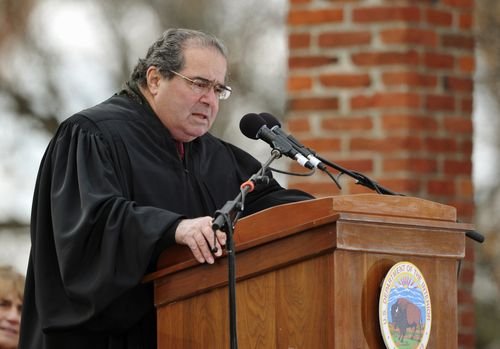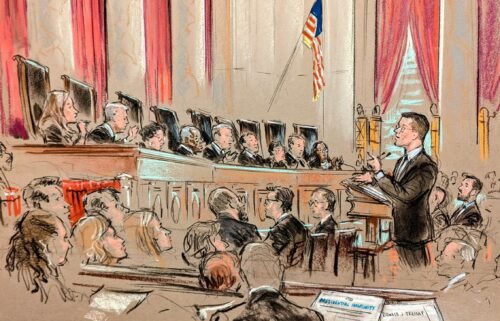Who will be the next Antonin Scalia? Conservatives fight over his legacy

Five years after the death of conservative hero Antonin Scalia, Supreme Court justices continue to joust over who among them is truly preserving — or, alternatively, disserving — his legacy.
Their moves will help define how the court’s six conservatives differentiate themselves from one another in cases and set the course of the nation’s law.
Chief Justice John Roberts, writing for a majority that revived a New Mexico woman’s claim of excessive force against police, and Justice Neil Gorsuch, dissenting, both claimed the Scalia mantle as they interpreted a relevant 1991 opinion of his regarding police seizures.
“At the end of the day,” Roberts wrote Thursday, “we simply agree with the analysis … set forth thirty years ago by Justice Scalia, joined by six of his colleagues, rather than the competing view urged by the dissent today.”
Roxanne Torres had been shot by police as she fled in her car, and the question was whether she had been “seized” under the Fourth Amendment, which protects against “unreasonable searches and seizures.”
“As Justice Scalia explained for himself and six other Members of the Court,” Roberts wrote, “the common law treated ‘the mere grasping or application of physical force with lawful authority,’ as an arrest, ‘whether or not it succeeded in subduing the arrestee.’ “
Gorsuch, writing for himself and two other dissenters, suggested Roberts’ reliance on Scalia was disingenuous. “After highlighting multiple times that Justice Scalia authored” the 1991 opinion, “the majority turns about and faults” Scalia’s writing in a separate case, Gorsuch said.
The Scalia-centered clash between Roberts and Gorsuch recalled a 2020 conflict between Gorsuch and Justice Samuel Alito. There, Gorsuch cited Scalia’s brand of textualism as he wrote a decision extending federal anti-discrimination coverage “because of sex” to LGBTQ workers.
Alito, dissenting, said Gorsuch was trying to pass off his interpretation “as the inevitable product of the textualist school of statutory interpretation championed by our late colleague Justice Scalia, but no one should be fooled.”
Alito compared the decision to a pirate ship, writing that “it sails under a textualist flag, but what it actually represents is a theory of statutory interpretation that Justice Scalia excoriated, the theory that courts should ‘up-date’ old statutes so that they better reflect the current values of society.”
These recent debates represent more than wrestling over who can best channel Scalia, who during his 1986-2016 tenure was the leading light of the textualist approach to interpreting statues, focused on the plain words of a law, and of the originalist method of constitutional interpretation, tied to the 18th-century framers’ understanding of the document.
They are operating in new territory, with a 6-3 dominance over liberals since last year’s death of Justice Ruth Bader Ginsburg and the addition of Amy Coney Barrett, who once served Scalia as a law clerk. They are staking out positions along their own ideological spectrum.
Some on the right, notably Justice Clarence Thomas, have pushed hard to roll back liberal-era precedents, while Roberts has adopted a slower approach.
Alliances have been shifting and definitive versions of textualism and originalism remain elusive. Last year when Gorsuch was joined by Roberts and the liberal justices to expand anti-discrimination protections to LGBTQ employees, Alito, Thomas and Justice Brett Kavanaugh insisted Scalia’s textualist method should have produced the opposite result.
In Thursday’s dispute, Kavanaugh apparently cast the decisive vote with Roberts’ interpretation of precedent so Torres could press her claim of excessive force. They were joined by the court’s three remaining liberals: Justice Stephen Breyer, Sonia Sotomayor and Elena Kagan.
Barrett, confirmed to the high court in late October, was not yet seated when Torres v. Madrid was argued and did not vote in the case.
Turning to Scalia-like insults
In dissent, Gorsuch, joined by Thomas and Alito, wrote that the Roberts majority had disregarded the Constitution’s original and ordinary meaning: “Until today, a Fourth Amendment ‘seizure’ has required taking possession of someone or something.
Gorsuch mocked Roberts’ reference to a 1605 English common law dispute known as the Countess of Rutland’s Case. “Not even minor royalty can rescue the majority,” Gorsuch said and added, “We have no business wandering about and randomly grabbing volumes off the shelf, plucking out passages we like, scratching out bits we don’t, all before pasting our own new pastiche into the U.S. Reports,” bound volumes of Supreme Court decisions.
It seems apt that when the Scalia legacy is in dispute, justices can descend into sniping. He was a master of the memorable insult.
“I would hide my head in a bag,” Scalia wrote, if he had to join an opinion that began as one by Justice Anthony Kennedy did in the 2015 controversy over same-sex marriage. In another 2015 case, Scalia, again dissenting, referred to the court’s “interpretive jiggery-pokery.”
In yet another dissent, in 1989, he called a disputed sentencing commission “a sort of junior-varsity Congress.”
And that series makes another point: Scalia spent much of his three decades writing fiery dissents. His interpretive methods were on the fringe. But through the force of his persuasion, and more importantly the addition of conservative jurists, his methods moved to the mainstream.
The outcomes his methods produce vary, to be sure.
But even liberal Justice Kagan declared in a 2015 Harvard lecture honoring Scalia: “We’re all textualists now.”




